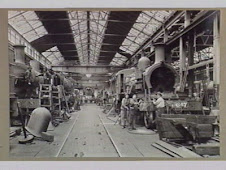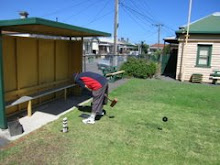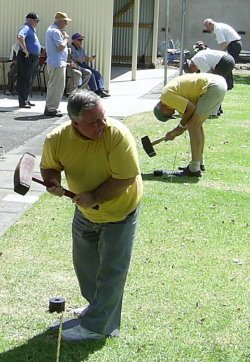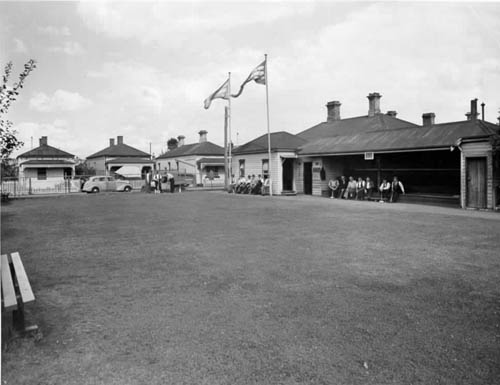Sunday, June 6, 2010
Friday, August 15, 2008
A short history of Trugo … and the Footscray Trugo Club
Imagine if you will this railway repair workshop in the western Melbourne suburb of Newport in the 1920s.
Just to alleviate the boredom of a lunch break, some of the workers started hitting black rubber rings (that were taken from the railway carriage buffers) with their mallets. They set up two cans as ‘goal posts’ 1.7 metres apart – the same width as your standard Melbourne railway gauge – and tried to hit the rings through the goal. To confirm that a goal was scored, someone behind the goal would shout, “That was a True Go.”
One of the workers, Thomas Grieves, kept on playing this game after his retirement, and decided to formalise Trugo as a sport. He formed Yarraville Trugo Club with his friend Claus Eberling and a few other local businessmen, and advertised Trugo as an ideal source of recreation for men aged over 60. This age restriction has stayed with the sport for most of its existence until recently, and now Trugo is open to men and women of all ages.
The first match was played on 12 March 1937, and the Footscray Trugo Club was formed a few weeks later, although the Club was not ‘officially’ launched until 14 May 1937. The first match between Footscray and Yarraville was on 18 June at Footscray’s first ‘home’ ground, Western Oval (now called the Whitten Oval).
Although Footscray Trugo Club wanted to keep Western Oval as its home, the council suggested another site, and in 1938 Trugo greens were laid out and a tiny pavilion was built on the corner of Buckley and Windsor Streets. This is our home ground to this day, and the clubroom is the oldest purpose built Trugo clubroom still in existence.
The shelter was extended in the early 1940s, and it is estimated that the fully enclosed clubroom that we have today was completed around 1950. A small extension to the building, which included female toilets, was built in 1965.
The Footscray Trugo Club has had limited success, with its only recorded premierships in 1948, 1949, 1951 and 1984 – bearing in mind that the winners in 1950 and between 1952-57 are unfortunately unknown. Despite this, the Club remains a vital part of Footscray, and hopefully season 2008-09 will be the year of the Yellow and Green.
Most of the information taken from this post is taken from the Footscray Trugo Club Conservation Analysis. It can be found at the Victorian Trugo Association website at http://home.vicnet.net.au/~vtrugo/title.htm
Just to alleviate the boredom of a lunch break, some of the workers started hitting black rubber rings (that were taken from the railway carriage buffers) with their mallets. They set up two cans as ‘goal posts’ 1.7 metres apart – the same width as your standard Melbourne railway gauge – and tried to hit the rings through the goal. To confirm that a goal was scored, someone behind the goal would shout, “That was a True Go.”
One of the workers, Thomas Grieves, kept on playing this game after his retirement, and decided to formalise Trugo as a sport. He formed Yarraville Trugo Club with his friend Claus Eberling and a few other local businessmen, and advertised Trugo as an ideal source of recreation for men aged over 60. This age restriction has stayed with the sport for most of its existence until recently, and now Trugo is open to men and women of all ages.
The first match was played on 12 March 1937, and the Footscray Trugo Club was formed a few weeks later, although the Club was not ‘officially’ launched until 14 May 1937. The first match between Footscray and Yarraville was on 18 June at Footscray’s first ‘home’ ground, Western Oval (now called the Whitten Oval).
Although Footscray Trugo Club wanted to keep Western Oval as its home, the council suggested another site, and in 1938 Trugo greens were laid out and a tiny pavilion was built on the corner of Buckley and Windsor Streets. This is our home ground to this day, and the clubroom is the oldest purpose built Trugo clubroom still in existence.
The shelter was extended in the early 1940s, and it is estimated that the fully enclosed clubroom that we have today was completed around 1950. A small extension to the building, which included female toilets, was built in 1965.
The Footscray Trugo Club has had limited success, with its only recorded premierships in 1948, 1949, 1951 and 1984 – bearing in mind that the winners in 1950 and between 1952-57 are unfortunately unknown. Despite this, the Club remains a vital part of Footscray, and hopefully season 2008-09 will be the year of the Yellow and Green.
Most of the information taken from this post is taken from the Footscray Trugo Club Conservation Analysis. It can be found at the Victorian Trugo Association website at http://home.vicnet.net.au/~vtrugo/title.htm
Subscribe to:
Posts (Atom)





